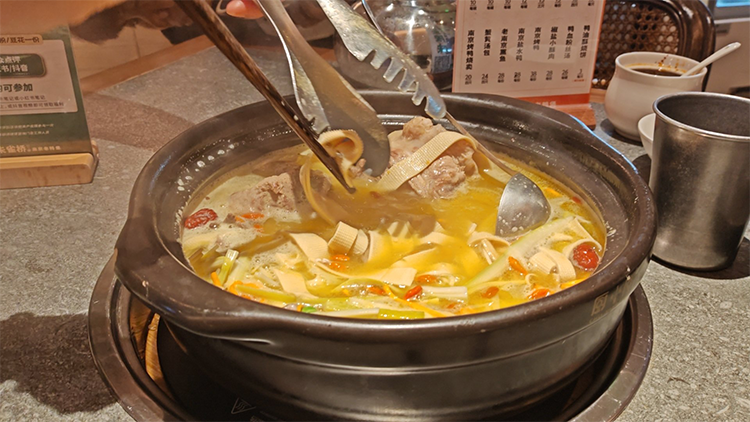Hangzhou Bamboo Shoot and Old Duck Pot
Imagine finishing a day of sightseeing around West Lake and sitting down in a warm, traditional restaurant to a steaming claypot of rich, clear broth, tender duck and fragrant dried bamboo shoots. This is Hangzhou’s famous dish, Bamboo Shoot and Old Duck Pot sǔn gān lǎo yā bāo). A classic of Zhejiang cuisine, this slow-simmered claypot soup combines local ingredients and centuries-old cooking techniques to produce a nourishing, savory experience beloved by locals and visitors alike.
1. Origin and History
The dish traces its roots to the Southern Song era (12th–13th centuries), when Hangzhou—then Lin’an—was China’s political and cultural center. Local households made simple, restorative stews using readily available ducks and preserved bamboo shoots. Over time, restaurants and gourmets adopted and refined the recipe, turning a humble home remedy into a celebrated Zhejiang specialty. While concrete historical records are sparse, literary references and culinary tradition tie the dish to the region’s long food culture and slow-cooking methods.

2. Cultural Significance
In Hangzhou’s rivers-and-lakes culture, this pot represents the ‘‘use-what’s-on-hand’’ philosophy: ducks and bamboo grow naturally in the Yangtze Delta, so the dish reflects seasonal, local eating. Often served at family gatherings, festivals, and official banquets, it symbolizes comfort, health and togetherness. Traditional Chinese dietary theory also praises the dish for balancing yin and yang: old duck provides nourishing, warming qualities while dried bamboo shoots add freshness and appetite-stimulating benefits.

3. Key Ingredients
The beauty of the dish lies in the careful selection of simple, local ingredients:
- Old duck: Typically a mature local duck (such as a Shaoxing or native mallard), chosen for firm texture and deeper flavor. Slow cooking renders it tender without turning mushy.
- Dried bamboo shoots (sǔn gān): Sun-dried or smoked shoots from nearby hills (for example, Tianmu Mountain). After soaking they regain a pleasant bite and soak up the broth’s richness.
- Ham: Thin slices of Jinhua or Xuanwei ham often add a salty, umami lift that deepens the soup.
- Aromatics and extras: Ginger, green onion, cooking wine and occasionally goji berries or light seasonings. These local products emphasize Zhejiang’s focus on freshness and subtlety.

4. Traditional Cooking Method
The traditional method uses a claypot or sandpot and slow, gentle heat. Basic steps are:
- Prep: Clean and cut the duck, blanch to remove impurities. Soak dried bamboo shoots until soft.
- Simmer base: In a claypot, add water or stock, duck, ginger and a splash of cooking wine. Bring to a boil, skim foam, then reduce to low heat and simmer 1–2 hours.
- Add main ingredients: Introduce the soaked bamboo shoots and ham slices, then continue simmering until the duck is tender and the flavors meld—another hour or so.
- Finish: Adjust seasoning lightly (ham already provides salt), top with scallions or goji berries, and serve straight from the pot. Total cooking time is usually 3–4 hours to achieve a clear, glossy broth and perfectly textured meat.
Many heritage restaurants still use charcoal-fired claypots to maintain authentic heat and flavor.

5. Flavor and Texture
The dish is best described as ‘‘rich yet not greasy, tender yet not falling apart.’’ The broth turns a clear, caramel tone—full-bodied from duck fat and ham but clean on the palate. Duck meat becomes melt-in-your-mouth tender with a bit of chew; dried bamboo shoots offer a slightly sweet, smoky note and pleasant bite. The result is layered umami rather than spicy heat, ideal for diners who appreciate subtle, savory depth.

6. How to Eat It
Bamboo Shoot and Old Duck Pot is usually a shared main course. Tradition suggests sipping the broth first, then tasting the meat and shoots. Typical accompaniments:
- Staple: Steamed white rice or plain noodles to soak up the soup.
- Side dishes: Light Zhejiang plates like cold cucumbers or West Lake vinegar fish to balance richness.
- Drink: Longjing (Dragon Well) tea from Hangzhou is a perfect counterpoint—its freshness cuts through the richness and refreshes the palate.
Use chopsticks for the solids and a spoon for the soup; servers often bring small bowls for sharing.

7. Where and When to Try It
- Best season: Autumn and winter (October–March) when hot soups are most comforting, though it’s available year-round.
- Recommended venues: Renowned Hangzhou restaurants and old teahouses near West Lake and the city center often serve authentic versions. Places with a reputation for traditional Zhejiang cooking—local favorites and historic eateries—are good choices.
- Practical tips: The dish is time-consuming to prepare, so popular restaurants may require reservations. It’s typically portioned for 2–4 people.

8. Traveler Tips
- Ordering: Use the English name “Bamboo Shoot and Old Duck Pot” or the Chinese name (sǔn gān lǎo yā bāo) on menus.
- Dietary notes: The soup is nourishing but includes salty ham; request reduced salt if needed.
- Cultural note: Chinese meals are communal—expect shared plates and pass dishes politely using serving utensils.

9. Simple Home Version
If you can’t get to Hangzhou, try a simplified home version: use a slow cooker, mature duck pieces, soaked dried bamboo shoots, ham or bacon as a substitute, ginger and a splash of cooking wine. Slow-cook for 2–3 hours until flavors meld. While it won’t fully replicate a charcoal claypot, it delivers comforting, Hangzhou-inspired flavors.

Conclusion
Bamboo Shoot and Old Duck Pot is a culinary emblem of Hangzhou: locally sourced, gently prepared and deeply satisfying. Whether enjoyed at a lakeside restaurant or attempted at home, this dish offers a delicious window into Zhejiang cuisine and the region’s relaxed dining culture. On your next trip to Hangzhou, add this nourishing claypot to your must-try list—its warm broth and layered flavors are an unforgettable part of the city’s food scene.


